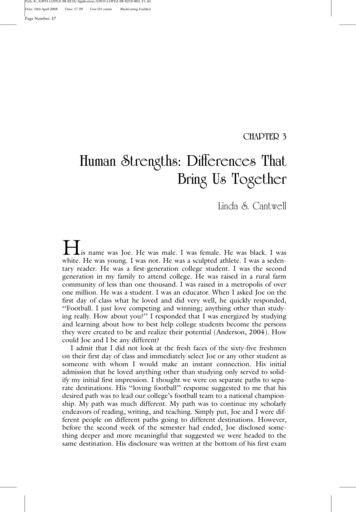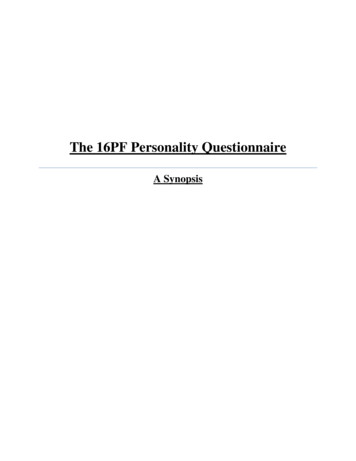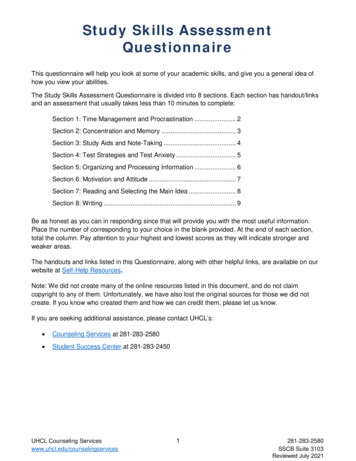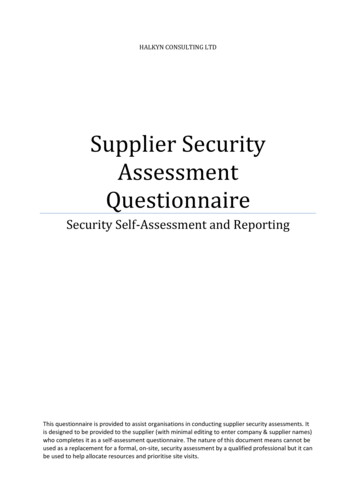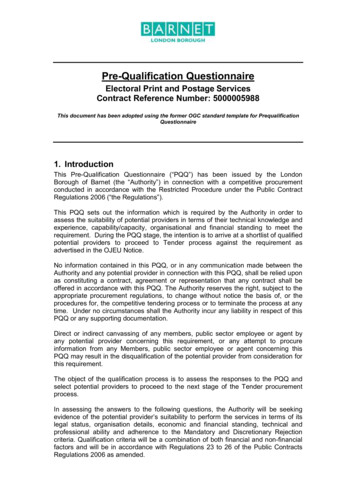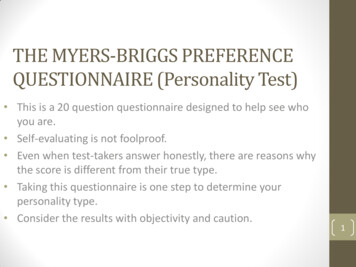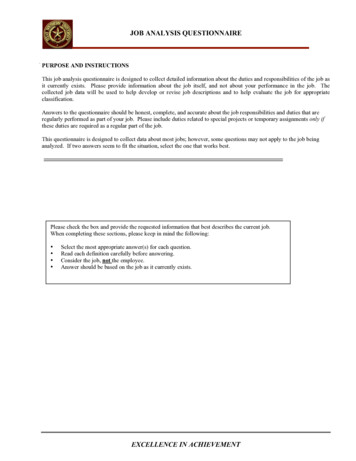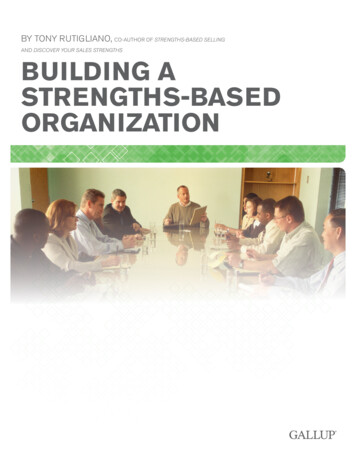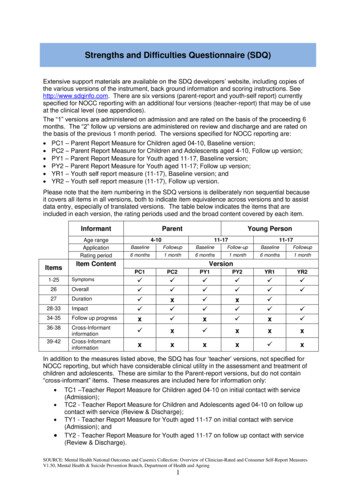
Transcription
Strengths and Difficulties Questionnaire (SDQ)Extensive support materials are available on the SDQ developers‟ website, including copies ofthe various versions of the instrument, back ground information and scoring instructions. Seehttp://www.sdqinfo.com. There are six versions (parent-report and youth-self report) currentlyspecified for NOCC reporting with an additional four versions (teacher-report) that may be of useat the clinical level (see appendices).The “1” versions are administered on admission and are rated on the basis of the proceeding 6months. The “2” follow up versions are administered on review and discharge and are rated onthe basis of the previous 1 month period. The versions specified for NOCC reporting are:PC1 – Parent Report Measure for Children aged 04-10, Baseline version;PC2 – Parent Report Measure for Children and Adolescents aged 4-10, Follow up version;PY1 – Parent Report Measure for Youth aged 11-17, Baseline version;PY2 – Parent Report Measure for Youth aged 11-17; Follow up version;YR1 – Youth self report measure (11-17), Baseline version; andYR2 – Youth self report measure (11-17), Follow up version.Please note that the item numbering in the SDQ versions is deliberately non sequential becauseit covers all items in all versions, both to indicate item equivalence across versions and to assistdata entry, especially of translated versions. The table below indicates the items that areincluded in each version, the rating periods used and the broad content covered by each item.InformantAge rangeApplicationRating periodItems1-25Young t34-35Follow up -upBaselineFollowup6 months1 month6 months1 month6 months1 monthPC1PC2PY1PY2YR1YR2 x x x x x x xxxxxxx xItem Content2639-42ParentVersion In addition to the measures listed above, the SDQ has four „teacher‟ versions, not specified forNOCC reporting, but which have considerable clinical utility in the assessment and treatment ofchildren and adolescents. These are similar to the Parent-report versions, but do not contain“cross-informant” items. These measures are included here for information only:TC1 –Teacher Report Measure for Children aged 04-10 on initial contact with service(Admission);TC2 - Teacher Report Measure for Children and Adolescents aged 04-10 on follow upcontact with service (Review & Discharge);TY1 - Teacher Report Measure for Youth aged 11-17 on initial contact with service(Admission); andTY2 - Teacher Report Measure for Youth aged 11-17 on follow up contact with service(Review & Discharge).SOURCE: Mental Health National Outcomes and Casemix Collection: Overview of Clinician-Rated and Consumer Self-Report MeasuresV1.50, Mental Health & Suicide Prevention Branch, Department of Health and Ageing1
Area LogoPC1Parent Report Measures forChildren and AdolescentsSDQ(P)04-10Facility Name:Code:Please used gummed label if availablePatient or Client Identifier: Surname:Other names:Date of Birth:Sex:Male 1/ /Female 2Address: Instructions: For each item, please mark the box for Not True, Somewhat True or Certainly True. It would help us if youanswered all items as best you can even if you are not absolutely certain. Please give your answers on the basis of yourchild‟s behaviour over the last six months.Strengths and Difficulties QuestionnaireNot TrueSomewhatTrueCertainlyTrueConsiderate of other people‟s feelings 2.Restless, overactive, cannot stay still for long 3.Often complains of headaches, stomach-aches or sickness 4.Shares readily with other children, for example toys, treats, pencils 5.Often loses temper 6.Rather solitary, prefers to play alone 7.Generally well behaved, usually does what adults request 8.Many worries or often seems worried 9.Helpful if someone is hurt, upset or feeling ill 10.Constantly fidgeting or squirming 11.Has at least one good friend 12.Often fights with other children or bullies them 13.Often unhappy, depressed or tearful 14.Generally liked by other children 15.Easily distracted, concentration wanders 16.Nervous or clingy in new situations, easily loses confidence 17.Kind to younger children 18.Often lies or cheats 19.Picked on or bullied by other children 20.Often volunteers to help others (parents, teachers, other children) 21.Thinks things out before acting 22.Steals from home, school or elsewhere 23.Gets along better with adults than with other children 24.Many fears, easily scared 25.Good attention span, sees chores or homework through to the end SOURCE: Mental Health National Outcomes and Casemix Collection: Overview of Clinician-Rated and Consumer Self-Report Measures V1.50,Mental Health & Suicide Prevention Branch, Department of Health and Ageing2SDQ (P) 04-10 SELF–REPORT MEASURE (1 of 2)1.
Please turn over – there are a few more questions on the other sideDo you have any other comments or concerns?Over the last six months, have your child‟s teachers complained of:NoA LittleA Lot36.Fidgetiness, restlessness or overactivity 37.Poor concentration or being easily distracted 38.Acting without thinking, frequently butting in, or not waiting for his orher turn 26Overall, do you think that your child has difficulties in anyof the following areas: emotions, concentration, behaviouror being able to get along with other people?NoYes –minordifficultiesYes –definitedifficultiesYes –severedifficulties 27281-5 months6-12monthsOver ayear Not at allA littleA mediumamountA greatdeal 30. FRIENDSHIPS 31. CLASSROOM LEARNING 32. LEISURE ACTIVITIES Do the difficulties put a burden on you or the family as awhole? How long have these difficulties been present?Do the difficulties upset or distress your child?Do the difficulties interfere with your child‟s everyday life in thefollowing areas?29. HOME LIFE33SignatureDateMother/Father/Other (please specify):Thank you very much for your help. Robert Goodman 2002SOURCE: Mental Health National Outcomes and Casemix Collection: Overview of Clinician-Rated and Consumer Self-Report Measures V1.50,Mental Health & Suicide Prevention Branch, Department of Health and Ageing3SDQ (P) 04-10 SELF–REPORT MEASURE (2of 2)Less thana monthModule PC1 v2If you have answered “Yes”, please answer the following questions about these difficulties:
Area LogoPC2Parent Report Measures forChildren and AdolescentsSDQ(P)04-10 FUPlease used gummed label ifavailablePatient or Client Identifier: Surname:Other names:Date of Birth:Sex:Male 1/ /Facility Name:Code: Female 2Address:Instructions: For each item, please mark the box for Not True, Somewhat True or Certainly True. It would helpus if you answered all items as best you can even if you are not absolutely certain. Please give your answers onthe basis of your child‟s behaviour over the last month.Strengths and Difficulties QuestionnaireNot TrueSomewhatTrueCertainlyTrueConsiderate of other people‟s feelings 2.Restless, overactive, cannot stay still for long 3.Often complains of headaches, stomach-aches, or sickness 4.Shares readily with other children, for example toys, treats, pencils 5.Often loses temper 6.Rather solitary, prefers to play alone 7.Generally well behaved, usually does what adults request 8.Many worries or often seems worried 9.Helpful if someone is hurt, upset or feeling ill 10.Constantly fidgeting or squirming 11.Has at least one good friend 12.Often fights with other children or bullies them 13.Often unhappy, depressed or tearful 14.Generally liked by other children 15.Easily distracted, concentration wanders 16.Nervous or clingy in new situations, easily loses confidence 17.Kind to younger children 18.Often lies or cheats 19.Picked on or bullied by other children 20.Often volunteers to help others (parents, teachers, other children) 21.Thinks things out before acting 22.Steals from home, school or elsewhere 23.Gets along better with adults than with other children 24.Many fears, easily scared 25.Good attention span, sees chores or homework through to the end Please turn over – there are a few more questions on the other sideDo you have any other comments or concerns?SOURCE: Mental Health National Outcomes and Casemix Collection: Overview of Clinician-Rated and Consumer Self-Report Measures V1.50, MentalHealth & Suicide Prevention Branch, Department of Health and Ageing4SDQ (P) 04-10 FU SELF–REPORT MEASURE (1 of 2)1.
343526Since coming to the service, are your child‟sproblems:MuchworseA bit worseAbout thesameA bit betterMuchbetter Has coming to the service been helpful in other wayse.g. providing information or making the problems morebearable?Overall, do you think that your child has difficulties inany of the following areas: emotions, concentration,behaviour or being able to get along with other people?Not at allA little A mediumA great dealamount NoYes –minordifficultiesYes –definitedifficultiesYes –severedifficulties If you have answered “Yes”, please answer the following questions about these difficulties:A mediumamountA greatdeal 30 FRIENDSHIPS 31 CLASSROOM LEARNING 32. LEISURE ACTIVITIES Do the difficulties put a burden on you or the family as awhole? Do the difficulties upset or distress your child?Do the difficulties interfere with your child‟s everyday life in thefollowing areas?29. HOME LIFE33SignatureDateMother/Father/Other (please specify):Thank you very much for your help. Robert Goodman 2002SOURCE: Mental Health National Outcomes and Casemix Collection: Overview of Clinician-Rated and Consumer Self-Report Measures V1.50, MentalHealth & Suicide Prevention Branch, Department of Health and Ageing5SDQ (P) 04-10 FU SELF–REPORT MEASURE (2 of 2)A littleModule PC2 v228Not at all
Area LogoPlease used gummed label ifavailableParent Report Measures forChildren and AdolescentsSDQ(P)11-17Other names:Date of Birth:/ /Code: Surname:PY1Facility Name:Patient or Client Identifier: Sex:Male 1Female 2Address:Instructions: For each item, please mark the box for Not True, Somewhat True or Certainly True. It would help us if youanswered all items as best you can even if you are not absolutely certain. Please give your answers on the basis of yourchild‟s behaviour over the last six months.Strengths and Difficulties QuestionnaireNot True SomewhatTrueCertainlyTrueConsiderate of other people‟s feelings 2.Restless, overactive, cannot stay still for long 3.Often complains of headaches, stomach-aches, or sickness 4.Shares readily with other young people, for example CDs, games, food 5.Often loses temper 6.Would rather be alone than with other young people 7.Generally well behaved, usually does what adults request 8.Many worries or often seems worried 9.Helpful if someone is hurt, upset or feeling ill 10.Constantly fidgeting or squirming 11.Has at least one good friend 12.Often fights with other young people or bullies them 13.Often unhappy, depressed or tearful 14.Generally liked by other young people 15.Easily distracted, concentration wanders 16.Nervous in new situations, easily loses confidence 17.Kind to younger children 18.Often lies or cheats 19.Picked on or bullied by other young people 20.Often volunteers to help others (parents, teachers, children) 21.Thinks things out before acting 22.Steals from home, school or elsewhere 23.Gets along better with adults than with other young people 24.Many fears, easily scared 25.Good attention span, sees chores or homework through to the end Please turn over – there are a few more questions on the other sideSOURCE: Mental Health National Outcomes and Casemix Collection: Overview of Clinician-Rated and Consumer Self-Report Measures V1.50, MentalHealth & Suicide Prevention Branch, Department of Health and Ageing6SDQ (P) 11-17 SELF–REPORT MEASURE (1 of 2)1.
Do you have any other comments or concerns?Over the last six months, have your child‟s teachers complained of:NoA LittleA Lot36.Fidgetiness, restlessness or overactivity 37.Poor concentration or being easily distracted 38.Acting without thinking, frequently butting in, or not waiting for hisor her turn 26.Overall, do you think that your child has difficulties in anyof the following areas: emotions, concentration, behaviouror being able to get along with other people?NoYes –minordifficultiesYes –definitedifficultiesYes –severedifficulties If you have answered “Yes”, please answer the following questions about these difficulties:27.1-5months6-12monthsOver ayear Not at allA littleA mediumamountA greatdeal 30. FRIENDSHIPS 31. CLASSROOM LEARNING 32. LEISURE ACTIVITIES Do the difficulties put a burden on you or the family as awhole? How long have these difficulties been present?Do the difficulties upset or distress your child?Do the difficulties interfere with your child‟s everyday life in thefollowing areas?29. HOME LIFE33.SignatureDateMother/Father/Other (please specify):Thank you very much for your help. Robert Goodman 2002SOURCE: Mental Health National Outcomes and Casemix Collection: Overview of Clinician-Rated and Consumer Self-Report Measures V1.50, MentalHealth & Suicide Prevention Branch, Department of Health and Ageing7SDQ (P) 11-17 SELF–REPORT MEASURE (2of 2)28.Less thana month
Area LogoPY2Parent Report Measures forChildren and AdolescentsSDQ(P)11-17 FUPlease used gummed label ifavailablePatient or Client Identifier: Surname:Other names:Date of Birth:Sex:Male 1/ /Facility Name:Code: Female 2Address:Instructions: For each item, please mark the box for Not True, Somewhat True or Certainly True. It would help us if youanswered all items as best you can even if you are not absolutely certain. Please give your answers on the basis of yourchild‟s behaviour over the last month.Strengths and Difficulties QuestionnaireNot TrueSomewhatTrueCertainlyTrue1.Considerate of other people‟s feelings 2.Restless, overactive, cannot stay still for long 3.Often complains of headaches, stomach-aches, or sickness 4.Shares readily with other young people, for example CDs, games,food 5.Often loses temper 6.Would rather be alone than with other young people 7.Generally well behaved, usually does what adults request 8.Many worries or often seems worried 9.Helpful if someone is hurt, upset or feeling ill 10.Constantly fidgeting or squirming 11.Has at least one good friend 12.Often fights with other young people or bullies them 13.Often unhappy, depressed or tearful 14.Generally liked by other young people 15.Easily distracted, concentration wanders 16.Nervous in new situations, easily loses confidence 17.Kind to younger children 18.Often lies or cheats 19.Picked on or bullied by other young people 20.Often volunteers to help others (parents, teachers, children) 21.Thinks things out before acting 22.Steals from home, school or elsewhere 23.Gets along better with adults than with other young people 24.Many fears, easily scared 25.Good attention span, sees chores or homework through to the end SOURCE: Mental Health National Outcomes and Casemix Collection: Overview of Clinician-Rated and Consumer Self-Report Measures V1.50, MentalHealth & Suicide Prevention Branch, Department of Health and Ageing8SDQ (P) 11-17 FU SELF–REPORT MEASURE (1 of 2)Please turn over – there are a few more questions on the other side
Do you have any other comments or concerns?34.35.26.Since coming to the service, are your child‟sproblems:MuchworseA bit worseAbout thesameA bit betterMuchbetter Has coming to the service been helpful in other wayse.g. providing information or making the problems morebearable?Overall, do you think that your child has difficulties inany of the following areas: emotions, concentration,behaviour or being able to get along with other people?Not at allA little A mediumA great dealamount NoYes –minordifficultiesYes –definitedifficultiesYes –severedifficulties If you have answered “Yes”, please answer the following questions about these difficulties:A littleA mediumamountA greatdeal 30. FRIENDSHIPS 31. CLASSROOM LEARNING 32. LEISURE ACTIVITIES Do the difficulties put a burden on you or the family as awhole? Do the difficulties upset or distress your child?Do the difficulties interfere with your child‟s everyday life in thefollowing areas?29. HOME LIFE33.SignatureDateMother/Father/Other (please specify):Thank you very much for your help. Robert Goodman 2002SOURCE: Mental Health National Outcomes and Casemix Collection: Overview of Clinician-Rated and Consumer Self-Report Measures V1.50, MentalHealth & Suicide Prevention Branch, Department of Health and Ageing9SDQ (P) 11-17 FU SELF–REPORT MEASURE (2 of 2)28.Not at all
Area LogoYR1Youth Report Measures forChildren and AdolescentsSDQ(S)11-17Please used gummed label ifavailableCode: Surname:Other names:Date of Birth:/ /Facility Name:Patient or Client Identifier:Sex:Male 1Female 2Address:Instructions: For each item, please mark the box for Not True, Somewhat True or Certainly True. It would help us if youanswered all items as best you can even if you are not absolutely certain. Please give your answers on the basis of howthings have been for you over the last six months.Strengths and Difficulties QuestionnaireNot True SomewhatTrueCertainlyTrueI try to be nice to other people. I care about their feelings 2.I am restless, I cannot stay still for long 3.I get a lot of headaches, stomach-aches, or sickness 4.I usually share with others, for example CDs, games, food 5.I get very angry and often lose my temper 6.I would rather be alone than with people of my age 7.I usually do as I am told 8.I worry a lot 9.I am helpful if someone is hurt, upset or feeling ill 10.I am constantly fidgeting or squirming 11.I have one good friend or more 12.I fight a lot. I can make other people do what I want 13.I am often unhappy, depressed or tearful 14.Other people my age generally like me 15.I am easily distracted, I find it difficult to concentrate 16.I am nervous in new situations. I easily lose confidence 17.I am kind to younger children 18.I am often accused of lying or cheating 19.Other children or young people pick on me or bully me 20.I often volunteer to help others (parents, teachers, children) 21.I think before I do things I take things that are not mine from home, school or elsewhere 23.I get along better with adults than with people my own age 24.I have many fears, I am easily scared 25.I finish the work I‟m doing. My attention is good 22.Please turn over – there are a few more questions on the other sideDo you have any other comments or concerns?SOURCE: Mental Health National Outcomes and Casemix Collection: Overview of Clinician-Rated and Consumer Self-Report Measures V1.50, MentalHealth & Suicide Prevention Branch, Department of Health and Ageing10SDQ (S) 11-17 SELF–REPORT MEASURE (1 of 2)1.
NoA LittleA Lot39.Does your family complain about you having problems withoveractivity or poor concentration? 40.Do your teachers complain about you having problems withoveractivity or poor concentration? 41.Does your family complain about you being awkward ortroublesome? 42.Do your teachers complain about you being awkward ortroublesome? 26.Overall, do you think that you have difficulties in any ofthe following areas: emotions, concentration, behaviouror being able to get along with other people?NoYes –minordifficultiesYes –definitedifficultiesYes –severedifficulties If you have answered “Yes”, please answer the following questions about these difficulties:27.1-5 months6-12monthsOver ayear Not at allA littleA mediumamountA greatdeal 30. FRIENDSHIPS 31. CLASSROOM LEARNING 32. LEISURE ACTIVITIES Do the difficulties make it harder for those around you(family, friends, teachers, etc.)? How long have these difficulties been present?Do the difficulties upset or distress you?Do the difficulties interfere with your everyday life in thefollowing areas?29. HOME LIFE33.Your SignatureToday‟s DateThank you very much for your help. Robert Goodman 2002SOURCE: Mental Health National Outcomes and Casemix Collection: Overview of Clinician-Rated and Consumer Self-Report Measures V1.50, MentalHealth & Suicide Prevention Branch, Department of Health and Ageing11SDQ (S) 11-17 SELF–REPORT MEASURE (2of 2)28.Less thana month
Area LogoYR2Youth Report Measures forChildren and AdolescentsSDQ(S)11-17 FUPlease used gummed label ifavailablePatient or Client Identifier: Surname:Other names:Date of Birth:Sex:Male 1/ /Facility Name:Code: Female 2Address:Instructions: For each item, please mark the box for Not True, Somewhat True or Certainly True. It would help us if youanswered all items as best you can even if you are not absolutely certain. Please give your answers on the basis of howthings have been for you over the last month.Strengths and Difficulties QuestionnaireNot TrueSomewhatTrueCertainlyTrueI try to be nice to other people. I care about their feelings 2.I am restless, I cannot stay still for long 3.I get a lot of headaches, stomach-aches, or sickness 4.I usually share with others, for example CDs, games, food 5.I get very angry and often lose my temper 6.I would rather be alone than with people of my age 7.I usually do as I am told 8.I worry a lot 9.I am helpful if someone is hurt, upset or feeling ill 10.I am constantly fidgeting or squirming 11.I have one good friend or more 12.I fight a lot. I can make other people do what I want 13.I am often unhappy, depressed or tearful 14.Other people my age generally like me 15.I am easily distracted, I find it difficult to concentrate 16.I am nervous in new situations. I easily lose confidence 17.I am kind to younger children 18.I am often accused of lying or cheating 19.Other children or young people pick on me or bully me 20.I often volunteer to help others (parents, teachers, children) 21.I think before I do things 22.I take things that are not mine from home, school or elsewhere 23.I get along better with adults than with people my own age 24.I have many fears, I am easily scared 25.I finish the work I‟m doing. My attention is good Please turn over – there are a few more questions on the other sideDo you have any other comments or concerns?SOURCE: Mental Health National Outcomes and Casemix Collection: Overview of Clinician-Rated and Consumer Self-Report Measures V1.50, MentalHealth & Suicide Prevention Branch, Department of Health and Ageing12SDQ (S) 11-17 FU SELF–REPORT MEASURE (1 of 2)1.
34.35.26.MuchworseA bit worseAbout thesameA bit betterMuchbetter Since coming to the service, are yourproblems:Has coming to the service been helpful in other wayse.g. providing information or making the problems morebearable?Overall, do you think that you have difficulties in any ofthe following areas: emotions, concentration, behaviouror being able to get along with other people?Not at allA little A mediumA great dealamount NoYes –minordifficultiesYes –definitedifficultiesYes –severedifficulties If you have answered “Yes”, please answer the following questions about these difficulties:A littleA mediumamountA greatdeal 30. FRIENDSHIPS 31. CLASSROOM LEARNING 32. LEISURE ACTIVITIES Do the difficulties make it harder for those around you(family, friends, teachers, etc.)? Do the difficulties upset or distress you?Do the difficulties interfere with your everyday life in thefollowing areas?29. HOME LIFE33.Your SignatureToday‟s DateThank you very much for your help. Robert Goodman 2002NOTE: The SDQ forms displayed above are the generic forms used in NSW.SOURCE: Mental Health National Outcomes and Casemix Collection: Overview of Clinician-Rated and Consumer Self-Report Measures V1.50, MentalHealth & Suicide Prevention Branch, Department of Health and Ageing13SDQ (S) 11-17 FU SELF–REPORT MEASURE (2 of 2)28.Not at all
SDQ items and Scale Summary scoresThe first 25 items in the SDQ comprise 5 scales of 5 items each. It is usually easiest to score all5 scales before working out the Total Difficulties score. For data entry, the responses to itemsshould always be entered the same way (see below), but they are not all scored the same way.Somewhat True is always scored as 1, but the scoring of Not True and Certainly True varies witheach item (see Table 1). For each of the 5 scales the score can range from 0-10 if all 5 itemswere completed. Scale scores can be prorated if at least 3 items were completed.Table 1: The individual SDQ items and the Total score derived from them.NotTrueStandard Values for Data Entry DataSDQ Item number and descriptionelementEmotional Symptoms ScaleItem 03Often complains of headaches, .Item 08Many worries or often seems worriedItem 13Often unhappy, depressed or tearfulItem 16Nervous or clingy in new situations .Item 24Many fears, easily scaredConduct Problem ScaleItem 05Often loses temper .Item 07Generally well behaved .Item 12Often fights with other children .Item 18Often lies or cheatsItem 22Steals from home, school .Hyperactivity ScaleItem 02Restless, overactive .Item 10Constantly fidgeting Item 15Easily distracted .Item 21Thinks things out before actingItem 25Good attention span, Peer Problem ScaleItem 06Rather solitary, prefers to play aloneItem 11Has at least one good friendItem 14Generally liked by other childrenItem 19Picked on or bullied .Item 23Gets along better with adults Prosocial ScaleItem 01Considerate of other people‟s feelingsItem 04Shares readily with other children, Item 09Helpful if someone is hurt .Item 17Kind to younger childrenItem 20Often volunteers to help others SDQ Total Difficulties Score Sum of Scales belowEmotional Symptoms ScaleConduct Problem ScaleHyperactivity ScalePeer Problem tem 0-100-100-100-10NB. Bold items indicate reverse scoringSOURCE: Mental Health National Outcomes and Casemix Collection: Overview of Clinician-Rated and Consumer Self-Report MeasuresV1.50, Mental Health & Suicide Prevention Branch, Department of Health and Ageing14
Calculating the Summary scores for the five Scales (Scale Scores)Standard values must be used for coding Item responses and Summary scores. The standardvalues for coding individual Item responses are 0 (Not True), 1 (Somewhat True), 2 (CertainlyTrue); and the „missing‟ values 7 (Unable to rate), 8 (Protocol exclusion) and 9 (Missing data).The Item scores used in calculation are shown in the table above. For completed items(response coded 0, 1, 2) the Item scores are usually the same as the standard values. Theexceptions are items 07, 11, 14, 21 and 25, which are shown bolded in the table. These itemsare “reverse-scored”, that is, the standard value is mapped ( ) to Item scores as follows: 0 2,1 1, 2 0.Summary scores are only calculated if at least three of the five items have been completed (thatis, coded 0, 1 or 2). Otherwise the summary score is set to missing. For the Summary scores, themissing value used should be 99.The Summary scores are computed using the equation shown below, with the result beingrounded to the nearest whole number. In the first 25 SDQ questions, each summary scale iscomposed of five items.Summary scoreSum of Item scoresN of valid (completed) ItemsNumber of ItemsCalculating other diagnostic possibilitiesIn addition to their clinical value, the use of the perceptions of other informants can be used withan algorithm available from www.youthinmind.net to calculate other likely diagnostic options.Calculating the Total Difficulties scoresThe simplest way to calculate the total difficulties score is to add up the following summaryscores with the result being rounded to the nearest whole number.Total Score Emotional Scale Conduct Scale Hyperactivity Scale Peer Problem Scale.However, some of the summary scores may be missing. The rule is if more than one summaryscore is missing the Total Score is set to missing, value 99.SOURCE: Mental Health National Outcomes and Casemix Collection: Overview of Clinician-Rated and Consumer Self-Report MeasuresV1.50, Mental Health & Suicide Prevention Branch, Department of Health and Ageing15
Calculating the Impact ScoreTable 2: The individual SDQ impact items and the Total score derived from them.Item ResponsesStandard Value for Data Entry Not atallA littleA mediumamountA greatdeal0123DataelementSDQ Item number and descriptionItem ScoreSummaryscoreItem 28Difficulties upset or distress child0012Item 29Interfere with HOME LIFE0012Item 30Interfere with FRIENDSHIP0012Item 31Interfere with CLASSROOM LEARNING0012Item 32Interfere with LEISURE ACTIVITIES0012SDQ IMPACT SCORE0-10These questions are NOT completed if respondents have answered “No” to Item 26, which asksfor an overall opinion about difficulties being present. In this case, all Item responses for Items27 through 33 should be coded to “8” for “not applicable”, and the impact score should be codedto zero. Item 27 is not included in the Impact Score, since it assesses the chronicity of thedifficulties – the length of time they have been present. Item 33 is not included in the ImpactScore, since it assess the burden on others rather than on the child/ youth.The coded Item Responses for the remaining Items 28 through 32 have to be mapped to
Strengths and Difficulties Questionnaire Not True Somewhat True Certainly True 1. Considerate of other people‟s feelings 2. Restless, overactive, cannot stay still for long 3. O
